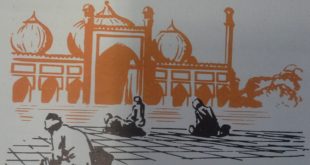Thirteen and a half centuries ago a new religion began in Arabia. Today millions of people are followers of this religion. It is called Islam and its followers, Moslems. All their lives long, Moslems must pray, in ways clearly prescribed, five times every day. No ordinary event must be allowed to interfere with these moments of prayer. Moslems must learn to recite their creed — a long statement of their religious belief. For one month each year they must fast all of every day from sunrise to sunset. They must give generously to charity. They should, if at all possible, go at least once during their lives to the holy city of Mecca, where Mohammed, the founder of Islam, began this new religion. People of other faiths are forbidden to enter Mecca. A few miles outside of Mecca, Moslems must change to pilgrims’ dress and proceed barefoot when they enter this city, high up in west-central Arabia. Mohammed and his first followers were Arabs. Arab merchants and Arab warriors, influenced the history of other peoples. United by loyalty to their religious faith, Arabs created a large empire. Arab rulers occupied positions of great influence and were keenly interested in advancing learning. How did all this come about? 1. How did the religion of Mohammed create a powerful Moslem world? 2. What kind of civilization developed in the Moslem world? 1. How did the Religion of Mohammed Create a Powerful Moslem World? Arab civilization started later than other great civilizations. The story of the Moslem world began about 600 A.D. in Arabia, a huge peninsula covered for the most part with burning desert. Arabia is separated from Africa by the Red Sea and from Iran (Persia) by the Persian Gulf. To the north and west of the Arabian peninsula is the …
Read More »The Abbasids: Glory and Decay 750 -1258 A. D.
UNDER THE Omayyads, who ruled from 661 to 750, Islam had grown into a mighty empire. Arabic had become its language, while the Arabs, in turn, had picked up useful skills from the peoples they had conquered. The state had grown rich from the tribute paid by non-Moslems and the land tax paid by landowners. Though the caliphs were mainly concerned with pleasure and power, they had not neglected religion completely. They had built the Dome of the Rock in Jerusalem and the Omayyad Mosque in Damascus — two magnificent sanctuaries which were the holiest places in Islam after the Kaaba and the Medina mosque. The believers had become divided, as they would remain divided, into Sunnites and Shiites. Now it was the turn of the Abbasids, who were to rule over the eastern part of the Arab Empire from 750 to 1258. Their first century of power was the Golden Age of Islam. Of all thirty-seven Abbassid caliphs, three stand out above the rest: al-Mansur, Harun al-Raschid and al-Mamun. Although he reigned after his brother the Bloodshedder, al-Mansur (754-775) was the real founder of the dynasty. It was he who firmly established it in power. He crushed a rebellion of Shiites. He raided the border strongholds of the Byzantines. He appointed the first vizier, or chief advisor. This practice, copied from the courts of the Persian emperors, was carried on by all the caliphs who came after him. BAGHDAD AND ITS RULERS Al-Mansur’s greatest achievement was building Baghdad, the fabled city of The Arabian Nights. He himself chose the site on the banks of the Tigris. Constructed in four years by a hundred thousand architects and workmen, Baghdad became the imperial capital of the Abbasids. It also became one of the greatest centres of trade in the world. To …
Read More »The Gift of the Nile 3300 B.C. – 30 B.C.
It was around 3500 B.C. and as it did every year around the middle of July, the Nile had begun to rise. Carrying tons of soil, the waters poured down from the mountains of Africa, where the rain and melting snow fed the streams that surfed northward into one great river. Wherever it ran free of the rocky canyons, the river overflowed onto the dry fields along its banks. It lapped against the villages on high ground and spread to market towns on the edges of the dessert. Moving northward, the river engulfed the entire Delta region and then emptied into the Mediterranean Sea. By mid-November the waters receded, leaving a thick, dark mud on the fields and in the canals. Near one of the largest towns far up the Nile, the farmers stood waiting at the edge of the fields. Then from the town came the king, followed by guards, priests and servants carrying large fans. The king wore a high white crown and carried a hoe. Scooping some fresh mud out of an irrigation ditch, he placed it in a basket held by an attendant. While the priests chanted, the mud was spread over the field. Now the farmers could plant in the fertile earth left by the floodwaters. The king, who was responsible for the well-being of his people, had performed a great duty. As his white crown indicated, this king ruled only in Upper Egypt. In the Delta to the North there was another king, who wore a red crown. For many years the people of Lower and Upper Delta had been fighting and raiding each other’s towns. However, they all had common ancestors who had come from Africa to the south, from Libya to the west and from Asia to the north and east. Through …
Read More »


